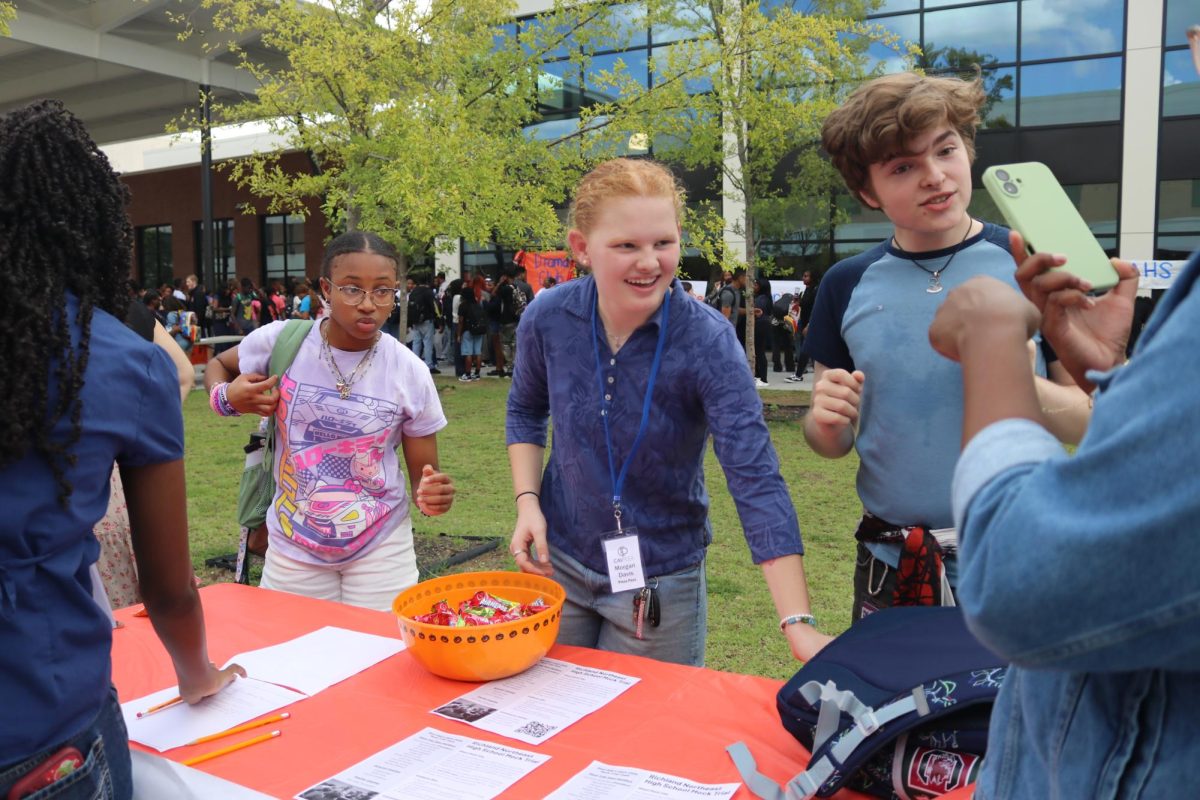The South Carolina Education Oversight Committee and the SC Department of Education recently released the annual school report cards. The academic, physical, and social conditions reviewed at Richland Northeast during the 2023-2024 school year were evaluated as “Unsatisfactory,” a rank below the “Below Average” it received the previous year. The rating was calculated through multiple factors, including academic achievement, graduation rate, high school student success, and social and physical climate.
Each factor was individually rated, which went into the overall score. This includes the student and teacher perceptions based on surveys taken by both groups during the year. But what went into such a rating in the first place? More importantly, how does all the data collected in the surveys tell a story about the school?
To start, each factor is rated on a scale of 1-5. It begins with a school rating and then average ratings from the school and district levels of the same factor as a comparison. Taken from the official SC School Report Card website, the general “Perceptions of School Climate” was rated 2.71 out of 5.

Translated into more qualitative data, these numbers suggest the climate is somewhere in the middle. It could be considered “below average” compared to the statewide rating of 3.45 out of 5, but otherwise, it’s a run-of-the-mill school.
The overall rating includes the section “Teacher Perceptions of Working Conditions.” 97 teachers responded to the survey. It indicated roughly the same statistics: RNE individually (3.41 out of 5) ranked a little lower than the state and district averages (3.77 and 3.54, respectively). Essentially, things could be better for teachers here, and may even be better in another district. But this number wasn’t dramatic and again showed that RNE is an average public high school.
However, the numbers began to tell a different story when RNE was rated considerably lower in the “Teacher Perceptions of Safety.” The individual school rating dropped to 2.96 out of 5, while the district and state averages were 3.31 and 4.16 out of 5, respectively. This marked the first of the below-average ratings that could have influenced the overall failing grade, showing that many teachers perceived the school as mediocre in its safety procedures, or perhaps even unsafe altogether.
Surprisingly, teachers who shared their opinions on the rating all said they felt safe on campus.
“Even before we got the metal detectors, I never felt uncomfortable. I never felt unsafe,” math teacher Devita Oliver said of her 18 years of teaching at RNE. “If there was something that I had to pinpoint, something that’s always been an issue is how open the campus is, in terms of [there seeming to be] 15,000 doors that all let you inside the building.”

Before tighter safety measures were put in place, she said, the numerous entrances allowed students to open the door for people they probably shouldn’t have. However, Oliver and other teachers seem to agree the safety measures around the school are adequate, especially with the addition of the metal detectors, said biology teacher Dawn Fluellen.
“Before we had them, we did have a lot of issues with weapons being brought into school,” Fluellen said. She added that may have contributed to dissatisfaction in previous years. “But I do think myself and a lot of the staff feel more comfortable now that the metal detectors are installed and students have to go through them no matter what time of day they’re coming on campus.”
Teachers expressed opinions about their physical working environment, though it may have been due to previously prevailing conditions. “I think that our custodial company could do a little better with the cleanliness of the bathrooms and keeping the hallways and classrooms clean,” Fluellen said. “But I’ve been here for 11 years, and they’ve always been our cleaning company, so that’s always been a complaint.”
First-year math teacher N’Kosi Ellis agrees about the cleanliness, though he doesn’t believe it’s always the fault of the staff or the majority of the student body.
“Chances are it might [only] be a couple of students out of the entire student body who don’t care to keep the bathrooms nice and pleasant,” Ellis said. “[But] the bathrooms are pretty uninviting.”
The 1,038 RNE students surveyed last year also had opinions about the climate. In fact, student opinion seemed to be the biggest factor in why the school climate was rated so low in the first place.
Senior Iris Ferguson has found plenty of reasons to like this school. She likes the physical layout of the school and the green spaces, such as the Shakespeare Garden. She also believes that many of the teachers legitimately care about the students and their learning. At the same time, she has a few complaints.
“Year after year the bathrooms have been a huge issue. I think it should be a basic human right for us to have access to clean bathrooms with toilet paper and soap and all the other things we need, and a lot of times we don’t have that,” Ferguson said.

She also has issues with school policy.
“I don’t know how many of the decisions made in our school’s policy recently were made by [admin or by the state], but I haven’t really been happy with a lot of our rules recently,” Ferguson said. “I think a lot of those policies are not designed to support more students being able to learn.”
For example, the updated dress code policy: “I think it should be as loose as it could be,” she said. “I understand that the reason policies like that are in place. [But] I think that there are lots of [things] that aren’t being considered by admin as for why students are wearing clothes that they deem inappropriate. There could be economic reasons, there could be health reasons.”
Ferguson provided insight into why the climate was rated as low as it was.
“To put it bluntly, I think it’s because a lot of people hate our school, because of faults both perceived and real,” Ferguson said.
Junior Lani Paul confirmed Ferguson’s opinions with her feelings about the survey.
“The kids grade stuff harsher than it really is… instead of [telling how conditions really are],” Paul said. “If people don’t like school in general, they might rate it [badly] just because they don’t like it.”
For example, if students see that the bathrooms are dirty, they’re going to report on the survey that more parts of the school are dirty as well, she said, while they really may not be.
Paul agreed with others about the cleanliness of the bathrooms. As for the learning environment, she says while some teachers are good at making school engaging for students, others seem to do the opposite.
“They just give you the work and tell you what to do,” Paul said, “and they don’t teach. A lot of times it’s very boring.”
As for how the climate has changed in the past year, she said that it hasn’t noticeably changed across the quality of education as well as cleanliness and the overall physical condition of the school.
“I feel like people are really starting to not care, and it shows. And sometimes teachers are just… there but not there,” Paul said. She believes this could create problems later on and lead to all aspects of school quality going downhill.
Interestingly, the opposite was mirrored in the report card. The “Student Perceptions of School Climate” rated 1.29 out of 5, though it had only been 0.97 the year before.
While the current overall average for the district is similar (1.37 out of 5), it’s still lower than the state average of 2.05. As reflected in Ferguson and Paul’s responses, students appear to be unsatisfied with the social and physical aspects of the school.

The same went for student perceptions of safety. Though this rating was higher than the climate average, it still ranked lower than the statewide average. This shows that like the teachers, students aren’t satisfied with safety measures, despite having metal detectors at the entrances and a team of school resource officers (SROs) within the premises at all times.
The students and teachers interviewed were mostly satisfied with school safety measures. Fluellen said that some survey responses could have been impacted by past conditions.
“I think that the older students who were here prior to us getting the detectors and were here to experience the weapons being brought on campus [were affected by that in their ratings],” Fluellen said.
Fluellen also provided considerable insight into why the survey responses from students were more negative than teacher responses. “I think that some students don’t take the survey seriously, and so they kind of make it a joke and click everything [as] ‘unsatisfactory.’ I don’t think they realize the impact that it has on us,” she said.
But that isn’t always the case. “Some students really are concerned with all of the factors that are on the survey, and they really are giving an honest opinion,” she said.
Another reason could be attributed to the general feeling some students have towards school, as Ellis pointed out. “[They may not] think of it as someplace that they enjoy as much as they enjoy other places. [Or] they might not be that interested in learning,” he said.

Whatever the reason, it’s clear that in some areas regarding the RNE setting, there is room for improvement. According to many, a change in how regularly the bathrooms are cleaned and stocked with supplies would be much appreciated.
In other regards, Ferguson believes that policy changes would be nice. “I’m not sure how many of those we could make, considering state oversights,” she said. “[For instance,] I’ve done research on [the recent phone ban] independently, because I’m really concerned about how it would impact the classroom experience… or rather how many kids [would be punished for breaking the rules] and therefore [have] their learning experience damaged. ” Knowing that the way each district enforces the ban is left up to them, she hopes that our district can create a phone policy that “prioritizes learning rather than punishment,” she said.
Policies regarding cell phones may impact report card results in the future, though it may be too early to speculate the extent.
Teachers have their own ideas on improvement as well. Over the years, Oliver has observed that the school sometimes puts increased emphasis on magnets due to the many opportunities they provide to students. “But what about your average, run-of-the-mill students who may not make it into a magnet program, but are still good at something?” she posed. “How do we engage those students not just in extracurriculars, but in academics as well to [the point] where they wanna try, and wanna do their best?” She herself didn’t know the exact answer to that question, but taking steps towards that on a school and even district level would be something she would love to see, she said.
This would likely help improve the general attitude students have towards school, and hence boost the report card score in the future.
Ellis agrees, saying that teachers could perhaps work together to ensure a more engaging classroom environment. “Students should want to be here,” he said. “They shouldn’t want to skip the class because of a teacher. They should be like, ‘At least I can go there and feel okay, I’m not gonna feel worse by going to this class.’”
He also believes that a more positive attitude towards school falls partly on the students. “I would love to see a bit more school spirit out of students,” he said. He believes that student pride in RNE isn’t as high as it could be. “I think a lot of people think it’s too uncool to show school spirit, or go to a certain event. But really, if they wanted the event to be more fun, all [they would] have to do is go there and make it more fun.”
Fluellen already sees some policies being implemented in attempts to improve the report card. “I do feel a sense of effort being put in by our admin team,” she said. For instance, she’s observed that less fights break out on the campus, and when they do, administrators are often quick to break it up.
As for further improvements that could be made, she partly agrees with Ellis. “I think we’ve got a group of students that don’t feel a sense of loyalty to school,” she said. “They don’t look at our school as a community and [believe that] what they do impacts everybody.” To use an example, she said, she often notices how some students leave their trash in the courtyard or the Shakespeare Garden at the end of lunch. They may not think much of it, but others like Fluellen certainly do. “It does bring down the environment of our school when kids really don’t care. If I could change anything, I would change that students really feel a sense of ownership of our school.”
“Our school report card impacts everyone,” she said. “It not only impacts our school, it impacts our district and it ultimately impacts the community around us when parents are deciding what school they’re going to send their child to.” She never thinks about leaving to go teach somewhere else, she said, because she knows how good of a school RNE is. “[I know] how hard our teachers work, and [how they] really want the best for our students. So I hate that parents will look at that report card and automatically strike us off the list as a place to send their student.”
Whether it be cleaning the school more thoroughly or making the classroom a space students enjoy being in, it’s clear that the school has to come up with ways to increase its report card rating in future years. But to that extent, RNE can take this year’s rating as a learning experience and take steps towards, in Fluellen’s words, working together school wide to make it a better place.
*This commentary is part of a series The Saber is covering on the School Report Card.
- Overall report on Richland Northeast 2023-2024 S.C. School Report Card
- Lunch and Learn: Staff impressions

















